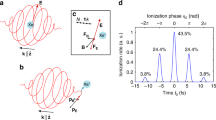Abstract
The timing of electron release in strong-field double ionization poses great challenges both for conceptual definition and for conducting experimental measurements. Here we present coincidence momentum measurements of the doubly charged ion and of the two electrons arising from double ionization of argon using elliptically polarized laser pulses. Based on a semi-classical model, the ionization times are calculated from the measured electron momenta across a large intensity range. This paper discusses how this method provides timings on a coarse and on a fine scale, similar to the hour and the minute hand of a clock. We found that the ionization time of the first electron is in good agreement with the simulation, whereas the ionization of the second electron occurs significantly earlier than predicted.
This is a preview of subscription content, access via your institution
Access options
Subscribe to this journal
Receive 12 print issues and online access
$209.00 per year
only $17.42 per issue
Buy this article
- Purchase on Springer Link
- Instant access to full article PDF
Prices may be subject to local taxes which are calculated during checkout




Similar content being viewed by others
References
Eckle, P. et al. Attosecond angular streaking. Nature Phys. 4, 565–570 (2008).
Eckle, P. et al. Attosecond ionization and tunnelling delay time measurements in helium. Science 322, 1525–1529 (2008).
Weber, T. et al. Correlated electron emission in multiphoton double ionization. Nature 405, 658–661 (2000).
Rudenko, A. et al. Correlated multielectron dynamics in ultrafast laser pulse interactions with atoms. Phys. Rev. Lett. 93, 253001 (2004).
Becker, W. & Rottke, H. Many-electron strong-field physics. Contemp. Phys. 49, 199–223 (2008).
Dörner, R. et al. in Advances in Atomic, Molecular, and Optical Physics, Vol. 48 (eds Bederson, B. & Walther, H.) 1–34 (Academic, 2002).
Maharjan, C. M. et al. Momentum imaging of doubly charged ions of Ne and Ar in the sequential ionization region. Phys. Rev. A 72, 041403 (2005).
Smolarski, M., Eckle, P., Keller, U. & Dörner, R. Semiclassical model for attosecond angular streaking. Opt. Express 18, 17640–17650 (2010).
Wang, X. & Eberly, J. H. Effects of elliptical polarization on strong-field short-pulse double ionization. Phys. Rev. Lett. 103, 103007 (2009).
Corkum, P. B. Plasma perspective on strong-field multiphoton ionization. Phys. Rev. Lett. 71, 1994–1997 (1993).
Tong, X. M. & Lin, C. D. Empirical formula for static field ionization rates of atoms and molecules by lasers in the barrier-suppression regime. J. Phys. B 38, 2593–2600 (2005).
Haessler, S. et al. Phase-resolved attosecond near-threshold photoionization of molecular nitrogen. Phys. Rev. A 80, 011404 (2009).
Schultze, M. et al. Delay in photoemission. Science 328, 1658–1662 (2010).
Telle, H. R. et al. Carrier-envelope offset phase control: A novel concept for absolute optical frequency measurement and ultrashort pulse generation. Appl. Phys. B 69, 327–332 (1999).
Litvinyuk, I. V. et al. Shakeup excitation during optical tunnel ionization. Phys. Rev. Lett. 94, 033003 (2005).
Ammosov, M. V., Delone, N. B. & Krainov, V. P. Tunnel ionization of complex atoms and of atomic ions in an alternating electromagnetic field. Sov. Phys. JETP 64, 1191–1194 (1986).
Taieb, R., Veniard, V. & Maquet, A. Photoelectron spectra from multiple ionization of atoms in ultra-intense laser pulses. Phys. Rev. Lett. 87, 053002 (2001).
Goulielmakis, E. et al. Real-time observation of valence electron motion. Nature 466, 739–743 (2010).
Walters, Z. B. & Smirnova, O. Attosecond correlation dynamics during electron tunnelling from molecules. J. Phys. B 43, 161002 (2010).
Gillen, G. D., Walker, M. A. & Van Woerkom, L. D. Enhanced double ionization with circularly polarized light. Phys. Rev. A 64, 043413 (2001).
Fittinghoff, D. N., Bolton, P. R., Chang, B. & Kulander, K. C. Observation of nonsequential double ionization of helium with optical tunneling. Phys. Rev. Lett. 69, 2642–2645 (1992).
Mauger, F., Chandre, C. & Uzer, T. Recollisions and correlated double ionization with circularly polarized light. Phys. Rev. Lett. 105, 083002 (2010).
Wang, X. & Eberly, J. H. Elliptical polarization and probability of double ionization. Phys. Rev. Lett. 105, 083001 (2010).
Hauri, C. P. et al. Generation of intense, carrier-envelope phase-locked few-cycle laser pulses through filamentation. Appl. Phys. B 79, 673–677 (2004).
Dörner, R. et al. Cold target recoil ion momentum spectroscopy: A ‘momentum microscope’ to view atomic collision dynamics. Phys. Rep. 330, 95–192 (2000).
Acknowledgements
This work was supported by the NCCR Quantum Photonics (NCCR QP), a research instrument of the Swiss National Science Foundation (SNSF), by ETH Research Grant ETH-03 09-2 and by the SNSF R’Equip grant 206021_128551/1. R.D. acknowledges support by a Koselleck Project of the Deutsche Forschungsgemeinschaft. We thank H. J. Wörner for enlightening discussions.
Author information
Authors and Affiliations
Contributions
A.N.P. and C.C. performed the experiments. A.N.P. analysed the data and implemented the simulation. All authors were involved in the interpretation. A.N.P., R.D. and U.K. wrote the manuscript.
Corresponding author
Ethics declarations
Competing interests
The authors declare no competing financial interests.
Supplementary information
Supplementary Information
Supplementary Information (PDF 488 kb)
Rights and permissions
About this article
Cite this article
Pfeiffer, A., Cirelli, C., Smolarski, M. et al. Timing the release in sequential double ionization. Nature Phys 7, 428–433 (2011). https://doi.org/10.1038/nphys1946
Received:
Accepted:
Published:
Issue Date:
DOI: https://doi.org/10.1038/nphys1946
This article is cited by
-
Spatiotemporal imaging and shaping of electron wave functions using novel attoclock interferometry
Nature Communications (2024)
-
Probing electron localization during molecular dissociation by femtosecond strong-field ion momentum spectroscopy
Communications Physics (2023)
-
Shepherd electron effects in multiple ionization of rubidium by circularly polarized intense laser fields
Communications Physics (2023)
-
Triple ionization and fragmentation of benzene trimers following ultrafast intermolecular Coulombic decay
Nature Communications (2022)
-
Fingerprints of slingshot non-sequential double ionization on two-electron probability distributions
Scientific Reports (2019)



